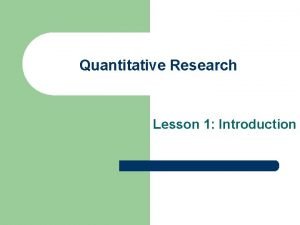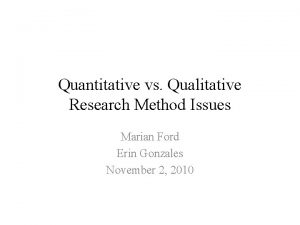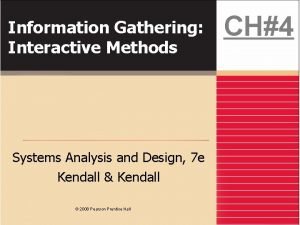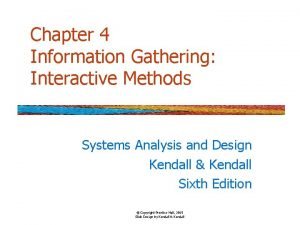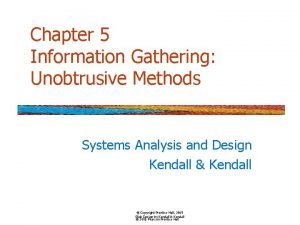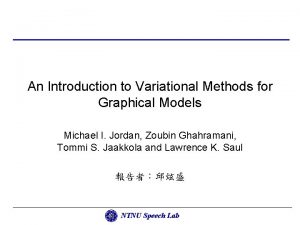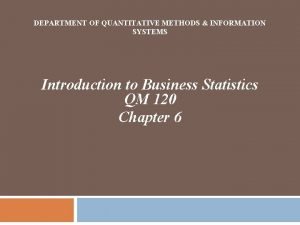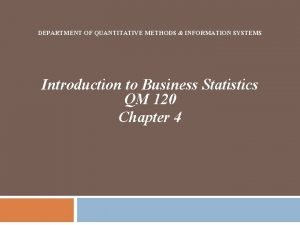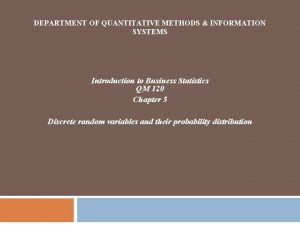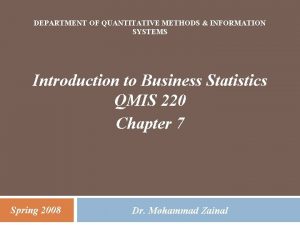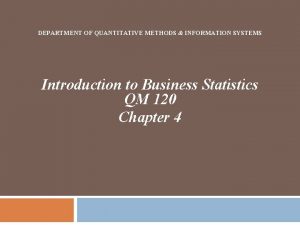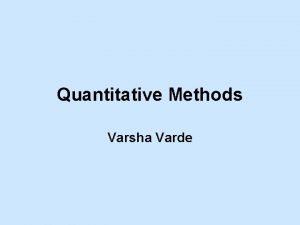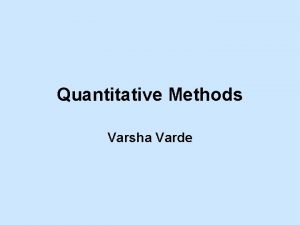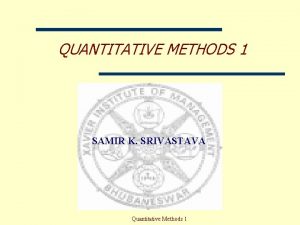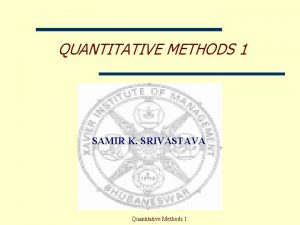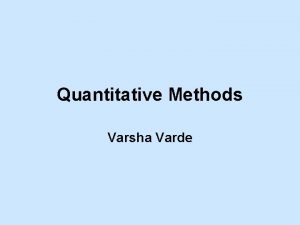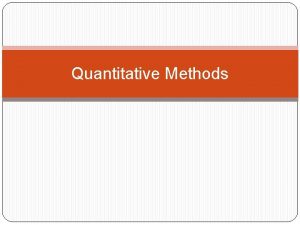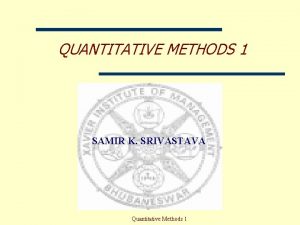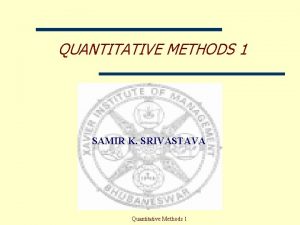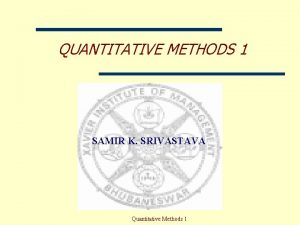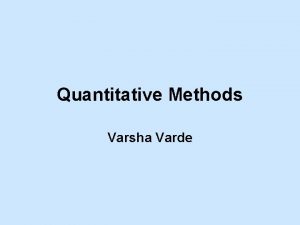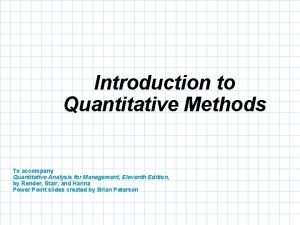DEPARTMENT OF QUANTITATIVE METHODS INFORMATION SYSTEMS Introduction to




































- Slides: 36

DEPARTMENT OF QUANTITATIVE METHODS & INFORMATION SYSTEMS Introduction to Business Statistics QM 120 Chapter 3

Measures of central tendency for ungrouped data 2 Graphs are very helpful to describe the basic shape of a data distribution; “a picture is worth a thousand words. ” There are limitations, however to the use of graphs. Ø One way to overcome graph problems is to use numerical measures, which can be calculated for either a sample or a population. Ø Numerical descriptive measures associated with a population of measurements are called parameters; those computed from sample measurements are called statistics. Ø A measure of central tendency gives the center of a histogram or frequency distribution curve. Ø Ø The measures are: mean, median, and mode.

Measures of central tendency for ungrouped data 3 Data that give information on each member of the population or sample individually are called ungrouped data, whereas grouped data are presented in the form of a frequency distribution table. Ø Mean The mean (average) is the most frequently used measure of central tendency. Ø The mean for ungrouped data is obtained by dividing the sum of all values by the number if values in the data set. Thus, Ø

Measures of central tendency for ungrouped data 4 Example: The following table gives the 2002 total payrolls of five MLB teams. 2002 total payroll MLB team 34 (millions of dollars) Anaheim Angels 62 Atlanta Braves 93 New York Yankees 126 St. Louis Cardinals 75 Tampa Bay Devil Rays 34 62 75 93 The Mean is a balancing point 126

Measures of central tendency for ungrouped data 5 Sometimes a data set may contain a few very small or a few very large values. Such values are called outliers or extreme values. Ø We should be very cautious when using the mean. It may not always be the best measure of central tendency. Ø Example: The following table lists the 2000 populations (in thousands) of five Pacific states. State Population (thousands) Washington 5894 Oregon 3421 Alaska Hawaii California An outlier 627 1212 33, 872 Excluding California Including California

Measures of central tendency for ungrouped data 6 Weighted Mean Ø Sometimes we may assign weight (importance) to each observation before we calculate the mean. Ø A mean computed in this manner is refereed to as a weighted mean and it is given by where xi is the value of observation i and Wi is weight for observation i.

Measures of central tendency for ungrouped data 7 Example: Consider the following sample of four purchases of one stock in the KSE. Find the average cost of the stock. Purchas e Price Quantity 1 . 300 5, 000 2 . 325 15, 000 3 . 350 10, 000 4 . 295 20, 000 x W x. W . 300 5, 000 1, 500 . 325 15, 000 4, 875 . 350 10, 000 3, 500 . 295 20, 000 5, 900 x. W = 15, 775 W = 50, 000 This is the x

Measures of central tendency for ungrouped data Median ØThe median is the value of the middle term in a data set has been ranked in increasing order. The value. 5(n + 1) indicates the position in the ordered data set. Ø If n is even, we choose a value halfway between the two middle observations Ø Example: Find the median for the following two sets of measurements 6 2 5 6 9 11 2, 9, 11, 5, 6, 27 2 5 6 9 11 27 2 5 6 9 11 2 7. 5 Between 3 rd & 4 th 2, 9, 11, 5, 6 3 rd 8

Measures of central tendency for ungrouped data 9 Mode The mode is the value that occurs with the highest frequency in a data set. Ø Ø A data with each value occurring only once has no mode. A data set with only one value occurring with highest frequency has only one mode, it is said to be unimodal. Ø A data set with two values that occurs with the same (highest) frequency has two modes, it is said to be bimodal. Ø If more than two values in a data set occur with the same (highest) frequency, it is said to be multimodal. Ø

Measures of central tendency for ungrouped data 10 Example: You are given 8 measurements: 3, 5, 4, 6, 12, 5, 6, 7. Find a) The mean. b) The median. c) The mode. 3 4 5 5 6 6 7 12 Relationships among the mean, median, and Mode Ø Symmetric histograms when Mean = Median = Mode Ø Right skewed histograms when Mean > Median > Mode Ø Left skewed histograms when Mean < Median < Mode

Measures of dispersion for ungrouped data 11 Range Data sets may have same center but look different because of the way the numbers are spread out from center. Ø Example: Company 1: 47 38 35 40 36 Company 2: 70 33 18 52 27 45 39 Measure of variability can help us to create a mental picture of the spread of the data. Ø Ø The range for ungrouped data Range = Largest value – Smallest value Ø The range, like the mean, is highly influenced by outliers. Ø The range is based on two values only.

Measures of dispersion for ungrouped data 12 Variance and standard deviation The standard deviation is the most used measure of dispersion. It tells us how closely the values of a data set are clustered around the mean. Ø In general, larger values of standard deviation indicate that values of that data set are spread over a relatively larger range around the mean and vice versa. Ø Ø Standard deviation is always non-negative

Measures of dispersion for ungrouped data 13 Example: Find the standard deviation of the data set in table. MLB team 2002 payroll (millions of dollars) Anaheim Angels 62 Atlanta Braves 93 New York Yankees 126 St. Louis Cardinals 75 Tampa Bay Devil Rays 34

Measures of dispersion for ungrouped data 14 In some situations we may be interested in a descriptive statistics that indicates how large is the standard deviation compared to the mean. Ø It is very useful when comparing two different samples with different means and standard deviations. Ø Ø It is given by:

Mean, variance, and standard deviation for grouped data 15 Mean for grouped data Once we group the data, we no longer know the values of individual observations. Ø Ø Thus, we find an approximation for the sum of these values.

Mean, variance, and standard deviation for grouped data 16 Variance and standard deviation for grouped data

Mean, variance, and standard deviation for grouped data 17 Example: The table below gives the frequency distribution of the daily commuting times (in minutes) from home to CBA for all 25 students in QMIS 120. Calculate the mean and the standard deviation of the daily commuting times. Ø Daily commuting time (min) f 0 to less than 10 4 10 to less than 20 9 20 to less than 30 6 30 to less than 40 4 40 to less than 50 2 Total 25

Use of standard deviation 18 Z-Scores We often are interested in the relative location of a data point xi with respect to the mean (how far or how close). Ø The z-scores (standardized value) can be used to find the relative location of a data point xi compared to the center of the data. Ø Ø It is given by The z-score can be interpreted as the number of standard deviations xi is from the mean. Ø

Use of standard deviation 19 Example: Find the z-scores for the following data where the mean is 44 and the standard deviation is 8. Number of students in a class 46 54 42 46 32

Use of standard deviation 20 Empirical Rule ØThe empirical rule gives more precise information about a data, however it only applies to a data set that is bell-shaped. Ø Theorem: 1 - 68% of the observations lie within one standard deviation of the mean. 2 - 95% of the observations lie within two standard deviations of the mean. 3 - 99. 7% of the observations lie within three standard deviations of the mean.

Use of standard deviation 21 Example: The age distribution of a sample of 5000 persons is bell -shaped with a mean of 40 years and a standard deviation of 12 years. Determine the approximate percentage of people who are 16 to 64 years old. Solution:

Use of standard deviation 22 Chebyshev's Theorem Chebyshev's theorem allows you to understand how the value of a standard deviation can be applied to any data set. Ø Chebyshev's theorem: The fraction of any data set lying within k standard deviations of the mean is at least Ø where k = a number greater than 1. This theorem applies to all data sets, which include a sample or a population. Ø Chebyshev’s theorem is very conservative but it can be applied to a data set with any shape. Ø

Use of standard deviation 23 k=2 k=3

Use of standard deviation 24 Example: Using Chebyshev’s theorem, suppose that the midterm test scores for 100 students in a university business statistics course had a mean of 70 and standard deviation 5. How many students had test scores between 60 and 80? How many students had scores between 58 and 82? Solution:

Use of standard deviation 25 2) For the test scores between 58 and 82

Use of standard deviation 26 Example: The average systolic blood pressure for 4000 women who were screened for high blood pressure was found to be 187 with standard deviation of 22. Using Chebyshev’s theorem, find at least what percentage of women in this group have a systolic blood pressure between 143 and 231. Solution:

Measure of position 27 Quartiles and interquartile range A measure of position which determines the rank of a single value in relation to other values in a sample or population. Ø Quartiles are three measures that divide a ranked data set into four equal parts Ø

Measure of position 28 Calculating the quartiles ØThe second quartile is the median of a data set. ØThe first quartile, Q 1, is the value of the middle term among observations that are less than the median. ØThe third quartile, Q 3, is the value of the middle term among observations that are greater than the median. Interquartile range (IQR) is the difference between the third quartile and the first quartile for a data set. Ø IQR = Interquartile range = Q 3 – Q 1

Measure of position 29 Example: For the following data 75. 3 82. 2 85. 8 88. 7 94. 1 102. 1 79. 0 97. 1 104. 2 119. 3 81. 3 77. 1 Find 1) The values of the three quartiles. 2) The interquartile range. 3) Where does the 104. 2 fall in relation to these quartiles. Solution:

Measure of position 30 Percentile and percentile rank Percentiles are the summery measures that divide a ranked data set into 100 equal parts. Ø The kth percentile is denoted by Pk , where k is an integer in the range 1 to 99. Ø Ø The approximate value of the kth percentile is

Measure of position 31 Example: For the following data 75. 3 82. 2 85. 8 88. 7 94. 1 102. 1 79. 0 97. 1 104. 2 119. 3 81. 3 77. 1 Find the value of the 40 th percentile. Solution:

Box-and-whisker plot 32 Box and whisker plot gives a graphic presentation of data using five measures: Ø ØQ 1, Q 2, Q 3, smallest, and largest values*. Can help to visualize the center, the spread, and the skewness of a data set. Ø Ø Can help in detecting outliers. Ø Very good tool of comparing more than a distribution. Ø Detecting an outlier: ØLower fence: Q 1 – 1. 5(IQR) ØUpper fence: Q 3 + 1. 5(IQR) ØIf a data point is larger than the upper fence or smaller than the lower fence, it is considered to be an outlier.

Box-and-whisker plot 33 To construct a box plot ØDraw a horizontal line representing the scale of the measurements. ØCalculate the median, the upper and lower quartiles, and the IQR for the data set and mark them on the line. ØForm a box just above the line with the right and left ends at Q 1 and Q 3. ØDraw a vertical line through the box at the location of the median. ØMark any outliers with an asterisk (*) on the graph. ØExtend horizontal lines called “Whiskers” from the ends of the box to the smallest and largest observation that are not outliers. * * Lower fence Q 1 Q 2 Q 3 Upper fence

Box-and-whisker plot 34 Example: Construct a box plot for the following data. 340 Solution: 300 470 340 320 290 260 330

Example 35 The following data reflect the number of customers who return merchandise for a refund on Monday. Note these data reflect the population of all 10 Mondays for which data are available. 40 46 12 13 17 22 25 16 9 7 Based on these data, what is the standard deviation? A) 39 B) 12. 36 C) 13. 03 D) 152. 8

Example 36 The number of days that homes stay on the market before they sell in Houston is bell-shaped with a mean equal to 56 days. Further, 95 percent of all homes are on the market between 40 and 72 days. Based on this information, what is the standard deviation for the number of days that houses stay on the market in Houston?
 Sampling methods in qualitative and quantitative research
Sampling methods in qualitative and quantitative research Integrating qualitative and quantitative methods
Integrating qualitative and quantitative methods Introduction to information systems 6th edition
Introduction to information systems 6th edition Introduction to information systems 6th edition
Introduction to information systems 6th edition Introduction to information systems 3rd edition
Introduction to information systems 3rd edition Introduction to information systems 5th edition
Introduction to information systems 5th edition User productivity system
User productivity system Introduction to accounting information systems
Introduction to accounting information systems Introduction to information systems 3rd edition
Introduction to information systems 3rd edition Introduction to information systems 3rd edition
Introduction to information systems 3rd edition Inlay wax pattern fabrication
Inlay wax pattern fabrication Lesson 1 introduction to quantitative research
Lesson 1 introduction to quantitative research Qualitative observation
Qualitative observation Agile embedded software development
Agile embedded software development Direct methods for sparse linear systems
Direct methods for sparse linear systems Effective methods for software and systems integration
Effective methods for software and systems integration Noaa
Noaa The engineering design of systems: models and methods
The engineering design of systems: models and methods Interactive methods of information gathering
Interactive methods of information gathering Information gathering: interactive methods
Information gathering: interactive methods Unobtrusive methods of information gathering
Unobtrusive methods of information gathering Different ways of presenting information
Different ways of presenting information Methods of acquiring information
Methods of acquiring information Acquiring information systems and applications
Acquiring information systems and applications Department of information technology
Department of information technology Department of information engineering university of padova
Department of information engineering university of padova Information engineering padova
Information engineering padova Department of the navy chief information officer
Department of the navy chief information officer Department of electronics & information technology
Department of electronics & information technology Electronics and information technology department odisha
Electronics and information technology department odisha Electroanalytical chemistry definition
Electroanalytical chemistry definition An introduction to variational methods for graphical models
An introduction to variational methods for graphical models Introduction methods results discussion conclusion
Introduction methods results discussion conclusion Introduction to chemistry section 3 scientific methods
Introduction to chemistry section 3 scientific methods Introduction to food and beverage service
Introduction to food and beverage service Introduction to food and beverage service
Introduction to food and beverage service Introduction of food and beverage service
Introduction of food and beverage service











